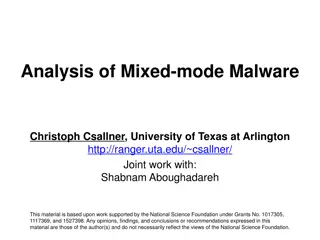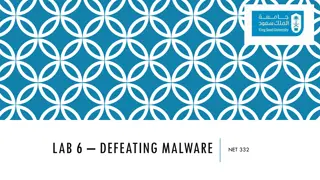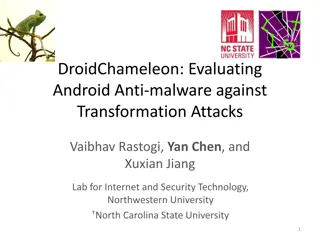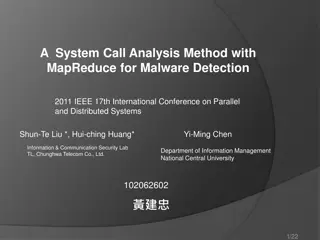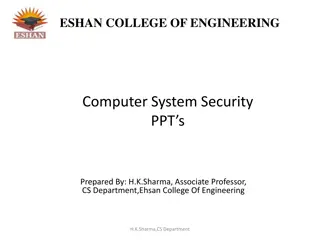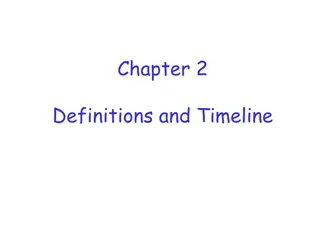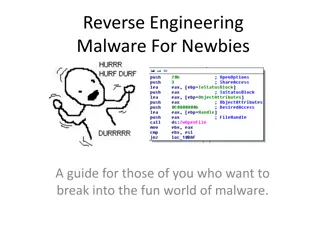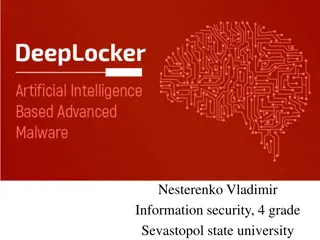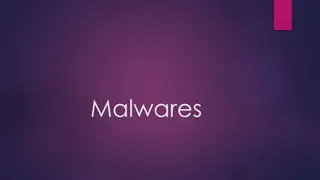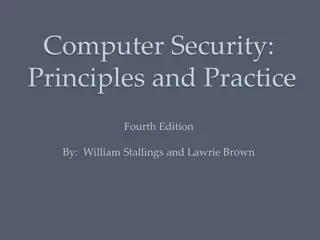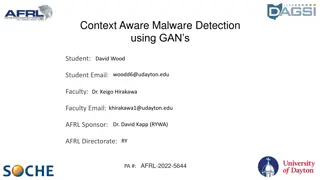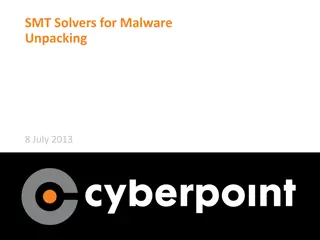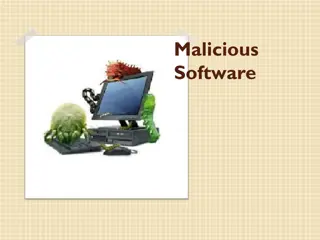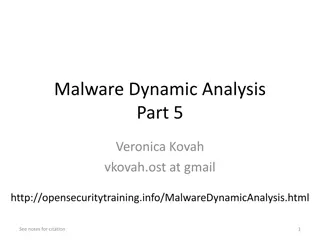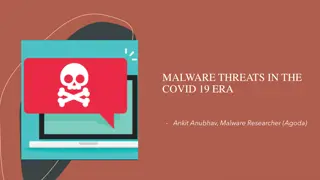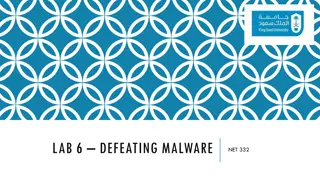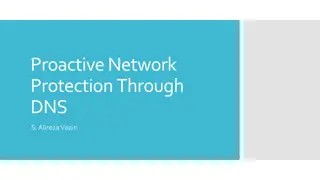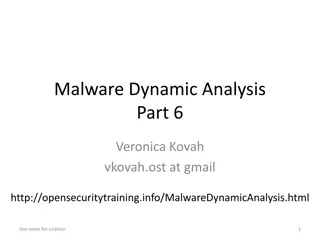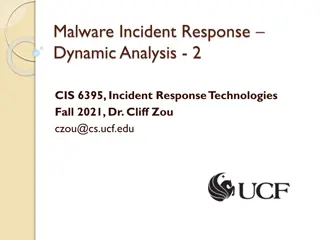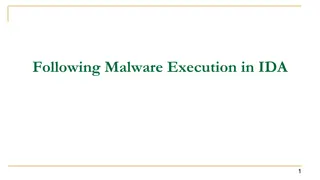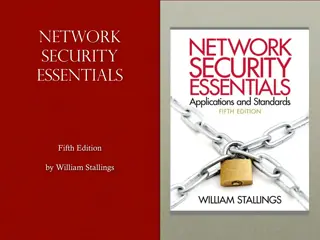Understanding Malware and Computer Security
Exploring the world of malware and computer security, this content delves into different types of malware such as Trojan horses, viruses, worms, and rootkits. It discusses how malware can violate site security policies and the covert actions they can carry out without detection. Examples like the Gemini malware designed for Android phones are detailed, shining a light on the threats posed by malicious software.
Download Presentation

Please find below an Image/Link to download the presentation.
The content on the website is provided AS IS for your information and personal use only. It may not be sold, licensed, or shared on other websites without obtaining consent from the author. Download presentation by click this link. If you encounter any issues during the download, it is possible that the publisher has removed the file from their server.
E N D
Presentation Transcript
Malware Chapter 23 Computer Security: Art and Science, 2nd Edition Version 1.0 Slide 23-1
Overview Defining malware (also called malicious logic) Types Trojan horses Computer viruses and worms Other types Theory: arbitrary program being a virus undecidable? Defenses Properties of malicious logic Trust Computer Security: Art and Science, 2nd Edition Version 1.0 Slide 23-2
Malware Set of instructions that cause site security policy to be violated Computer Security: Art and Science, 2nd Edition Version 1.0 Slide 23-3
Example Shell script on a UNIX system: cp /bin/sh /tmp/.xyzzy chmod u+s,o+x /tmp/.xyzzy rm ./ls ls $* Place in program called ls and trick someone into executing it You now have a setuid-to-them shell! Computer Security: Art and Science, 2nd Edition Version 1.0 Slide 23-4
Trojan Horse Program with an overt purpose (known to user) and a covert purpose (unknown to user) Often called a Trojan Named by Dan Edwards in Anderson Report Example: previous script is Trojan horse Overt purpose: list files in directory Covert purpose: create setuid shell Computer Security: Art and Science, 2nd Edition Version 1.0 Slide 23-5
Example: Gemini Designed for Android cell phones Placed in several Android apps on Android markets, forums When app was run: Gemini installed itself, using several techniques to make it hard to find Then it connected to a remote command and control server, waited for commands Commands it could execute included delete SMS messages; send SMS messages to remote server; dump contact list; dump list of apps Computer Security: Art and Science, 2nd Edition Version 1.0 Slide 23-6
Rootkits Trojan horse corrupting system to carry out covert actionwithout detection Earliest ones installed back doors so attackers could enter systems, then corrupted system programs to hide entry and actions Program to list directory contents altered to not include certain files Network status program altered to hide connections from specific hosts Computer Security: Art and Science, 2nd Edition Version 1.0 Slide 23-7
Example: Linux Rootkit IV Replaced system programs that might reveal its presence ls, find, du for file system; ps, top, lsof, killall for processes; crontab to hide rootkit jobs login and others to allow attacker to log in, acquire superuser privileges (and it suppressed any logging) netstat, ifconfig to hide presence of attacker tcpd, syslogd to inhibit logging Added back doors so attackers could log in unnoticed Also added network sniffers to gather user names, passwords Similar rootkits existed for other systems Computer Security: Art and Science, 2nd Edition Version 1.0 Slide 23-8
Defenses Use non-standard programs to obtain the same information that standard ones should; then compare ls lists contents of directory dirdump, a program to read directory entries, was non-standard Compare output to that if ls; if they differ, ls probably compromised Look for specific strings in executables Programs to do this analysis usually not rigged, but easy enough to write your own Look for changes using cryptographically strong checksums These worked because they bypassed system programs, using system calls directly Computer Security: Art and Science, 2nd Edition Version 1.0 Slide 23-9
Next Step: Alter the Kernel Rootkits then altered system calls using kernel-loadable modules Thereby eliminating the effectiveness of the earlier defenses Example: Knark modifies entries in system call table to involve versions in new kernel-loadable module; these hide presence of Knark Defense: compare system call table in kernel with copy stored at boot time Example: SucKIT changes variable in kernel that points to system call table so it points to a modified table, defeating the Knark defense Example: adore-ng modifies virtual file system layer to hide files with rootkit s UID or GID; manipulates /proc and other pseudofiles to control what process monitoring programs report Takes advantage of the ability to access OS entities like processes through file system Computer Security: Art and Science, 2nd Edition Version 1.0 Slide 23-10
Oops Sony BMG developed rootkit to implement DRM on a music CDsss Only worked on Windows systems; users had to install a proprietary program to play the music Also installed software that altered functions in Windows OS to prevent playing music using other programs This software concealed itself by altering kernel not to list any files or folders beginning with $sys$ and storing its software in such a folder On boot, software contacted Sony to get advertisements to display when music was played Once made public, attackers created Trojan horses with names beginning with $sys$ (like $sys$drv.exe ) Result: lawsuits, flood of bad publicity, and recall of all such CDs Computer Security: Art and Science, 2nd Edition Version 1.0 Slide 23-11
Replicating Trojan Horse Trojan horse that makes copies of itself Also called propagating Trojan horse Early version of animal game used this to delete copies of itself Hard to detect 1976: Karger and Schell suggested modifying compiler to include Trojan horse that copied itself into specific programs including later version of the compiler 1980s: Thompson implements this Computer Security: Art and Science, 2nd Edition Version 1.0 Slide 23-12
Thompson's Compiler Modify the compiler so that when it compiles login, login accepts the user's correct password or a fixed password (the same one for all users) Then modify the compiler again, so when it compiles a new version of the compiler, the extra code to do the first step is automatically inserted Recompile the compiler Delete the source containing the modification and put the undoctored source back Computer Security: Art and Science, 2nd Edition Version 1.0 Slide 23-13
The login Program user password login source correct compiler login executable logged in user password or magic password login source doctored compiler login executable logged in Computer Security: Art and Science, 2nd Edition Version 1.0 Slide 23-14
The Compiler login source compiler source correct compiler compiler executable correct login executable login source compiler source doctored compiler compiler executable rigged login executable Computer Security: Art and Science, 2nd Edition Version 1.0 Slide 23-15
Comments Great pains taken to ensure second version of compiler never released Finally deleted when a new compiler executable from a different system overwrote the doctored compiler The point: no amount of source-level verification or scrutiny will protect you from using untrusted code Also: having source code helps, but does not ensure you re safe Computer Security: Art and Science, 2nd Edition Version 1.0 Slide 23-16
Computer Virus Program that inserts itself into one or more files and performs some action Insertion phase is inserting itself into file Execution phase is performing some (possibly null) action Insertion phase must be present Need not always be executed Lehigh virus inserted itself into boot file only if boot file not infected Computer Security: Art and Science, 2nd Edition Version 1.0 Slide 23-17
Pseudocode beginvirus: ifspread-conditionthenbegin forsome set of target filesdobegin iftarget is not infectedthenbegin determine where to place virus instructions copy instructions from beginvirus to endvirus into target alter target to execute added instructions end; end; end; perform some action(s) gotobeginning of infected program endvirus: Computer Security: Art and Science, 2nd Edition Version 1.0 Slide 23-18
Trojan Horse Or Not? Yes Overt action = infected program s actions Covert action = virus actions (infect, execute) No Overt purpose = virus actions (infect, execute) Covert purpose = none Semantic, philosophical differences Defenses against Trojan horse also inhibit computer viruses Computer Security: Art and Science, 2nd Edition Version 1.0 Slide 23-19
History Programmers for Apple II wrote some Not called viruses; very experimental Fred Cohen Graduate student who described them Teacher (Adleman, of RSA fame) named it computer virus Tested idea on UNIX systems and UNIVAC 1108 system Computer Security: Art and Science, 2nd Edition Version 1.0 Slide 23-20
Cohens Experiments UNIX systems: goal was to get superuser privileges Max time 60m, min time 5m, average 30m Virus small, so no degrading of response time Virus tagged, so it could be removed quickly UNIVAC 1108 system: goal was to spread Implemented simple security property of Bell-LaPadula As writing not inhibited (no *-property enforcement), viruses spread easily Computer Security: Art and Science, 2nd Edition Version 1.0 Slide 23-21
First Reports of Viruses in the Wild Brain (Pakistani) virus (1986) Written for IBM PCs Alters boot sectors of floppies, spreads to other floppies MacMag Peace virus (1987) Written for Macintosh Prints universal message of peace on March 2, 1988 and deletes itself Computer Security: Art and Science, 2nd Edition Version 1.0 Slide 23-22
More Reports Duff s experiments (1987) Small virus placed on UNIX system, spread to 46 systems in 8 days Wrote a Bourne shell script virus Highland s Lotus 1-2-3 virus (1989) Stored as a set of commands in a spreadsheet and loaded when spreadsheet opened Changed a value in a specific row, column and spread to other files Computer Security: Art and Science, 2nd Edition Version 1.0 Slide 23-23
Infection Vectors Boot sector infectors Executable infectors Data infectors These are not mutually exclusive; some viruses do two or three of these Computer Security: Art and Science, 2nd Edition Version 1.0 Slide 23-24
Boot Sector Infectors A virus that inserts itself into the boot sector of a disk Section of disk containing code Executed when system first sees the disk Including at boot time Example: Brain virus Moves disk interrupt vector from 13H to 6DH Sets new interrupt vector to invoke Brain virus When new floppy seen, check for 1234H at location 4 If not there, copies itself onto disk after saving original boot block; if no free space, doesn t infect but if any free space, it infects, possibly overwriting used disk space If there, jumps to vector at 6DH Computer Security: Art and Science, 2nd Edition Version 1.0 Slide 23-25
Executable Infectors First program instruction to be executed Executable instructions and data Header 0 1000 100 Jump to the beginning of the virus Executable instructions and data Header Return to the beginning of the program A virus that infects executable programs Can infect either .EXE or .COM on PCs May append itself (as shown) or put itself anywhere, fixing up binary so it is executed at some point Version 1.0 Computer Security: Art and Science, 2nd Edition Slide 23-26
Executable Infectors (cont) Jerusalem (Israeli) virus Checks if system infected If not, set up to respond to requests to execute files Checks date If not 1987 or Friday 13th, set up to respond to clock interrupts and then run program Otherwise, set destructive flag; will delete, not infect, files Then: check all calls asking files to be executed Do nothing for COMMAND.COM Otherwise, infect or delete Error: doesn t set signature when .EXE executes So .EXE files continually reinfected Computer Security: Art and Science, 2nd Edition Version 1.0 Slide 23-27
Macro Viruses A virus composed of a sequence of instructions that are interpreted rather than executed directly Can infect either executables (Duff s shell virus) or data files (Highland s Lotus 1-2-3 spreadsheet virus) Independent of machine architecture But their effects may be machine dependent Computer Security: Art and Science, 2nd Edition Version 1.0 Slide 23-28
Example Melissa Infected Microsoft Word 97 and Word 98 documents Windows and Macintosh systems Invoked when program opens infected file Installs itself as open macro and copies itself into Normal template This way, infects any files that are opened in future Invokes mail program, sends itself to everyone in user s address book Used a mail program that most Macintosh users didn t use, so this was rare for Macintosh users Computer Security: Art and Science, 2nd Edition Version 1.0 Slide 23-29
Multipartite Viruses A virus that can infect either boot sectors or executables Typically, two parts One part boot sector infector Other part executable infector Computer Security: Art and Science, 2nd Edition Version 1.0 Slide 23-30
Concealment Terminate and stay resident (TSR) Stealth Encryption Polymorphism Metamorphism Computer Security: Art and Science, 2nd Edition Version 1.0 Slide 23-31
TSR Viruses A virus that stays active in memory after the application (or bootstrapping, or disk mounting) is completed Non-TSR viruses only execute when host application executes Examples: Brain, Jerusalem viruses Stay in memory after program or disk mount is completed Computer Security: Art and Science, 2nd Edition Version 1.0 Slide 23-32
Stealth Viruses A virus that conceals infection of files Example: IDF (also called Stealth or 4096) virus modifies DOS service interrupt handler as follows: Request for file length: return length of uninfected file Request to open file: temporarily disinfect file, and reinfect on closing Request to load file for execution: load infected file Computer Security: Art and Science, 2nd Edition Version 1.0 Slide 23-33
Encrypted Viruses A virus that is enciphered except for a small deciphering routine Detecting virus by signature now much harder as most of virus is enciphered Deciphering key Deciphering routine Enciphered virus code Virus code Version 1.0 Computer Security: Art and Science, 2nd Edition Slide 23-34
Example (* Decryption code of the 1260 virus *) (* initialize the registers with the keys *) rA = k1; rB = k2; (* initialize rC with the virus; starts at sov, ends at eov *) rC = sov; (* the encipherment loop *) while (rC != eov) do begin (* encipher the byte of the message *) (*rC) = (*rC) xor rA xor rB; (* advance all the counters *) rC = rC + 1; rA = rA + 1; end Computer Security: Art and Science, 2nd Edition Version 1.0 Slide 23-35
Polymorphic Viruses A virus that changes its form each time it inserts itself into another program Idea is to prevent signature detection by changing the signature or instructions used for deciphering routine At instruction level: substitute instructions At algorithm level: different algorithms to achieve the same purpose Toolkits to make these exist (Mutation Engine, Trident Polymorphic Engine) After decipherment, same virus loaded into memory Virus is encrypted; decryption routine is obscured (polymorphicized?) Computer Security: Art and Science, 2nd Edition Version 1.0 Slide 23-36
Example These are different instructions (with different bit patterns) but have the same effect: add 0 to register subtract 0 from register xor 0 with register no-op Polymorphic virus would pick randomly from among these instructions Computer Security: Art and Science, 2nd Edition Version 1.0 Slide 23-37
Metamorphic Like polymorphic, but virus itself is also obscured So two instances of virus would look different when loaded into memory When decrypted, virus may have: Two completely different implementations Two completely different algorithms producing same result Computer Security: Art and Science, 2nd Edition Version 1.0 Slide 23-38
Example W95/Zmist virus distributes pitself throughout code being infected On finding file to infect: p = 0.1: insert jump instructions between each set of non-jump instructions p = 0.1: infect file with unencrypted copy of Zmist p = 0.8: if file has section with initialized data that is writeable, infect file with polymorphic encrypted version of Zmist; otherwise, infect file with unencrypted copy of Zmist In first case, virus expands that section, inserts virus code as it is decrypted, and executes that code; decrypting code preserves registers so they can be restored On execution, allocates memory to put virus engine in; that creates new instance of (transformed) virus Computer Security: Art and Science, 2nd Edition Version 1.0 Slide 23-39
Computer Worms A program that copies itself from one computer to another Origins: distributed computations Schoch and Hupp: animations, broadcast messages Segment: part of program copied onto workstation Segment processes data, communicates with worm s controller Any activity on workstation caused segment to shut down Computer Security: Art and Science, 2nd Edition Version 1.0 Slide 23-40
Example: Internet Worm of 1988 Targeted Berkeley, Sun UNIX systems Used virus-like attack to inject instructions into running program and run them To recover, had to disconnect system from Internet and reboot To prevent re-infection, several critical programs had to be patched, recompiled, and reinstalled Analysts had to disassemble it to uncover function Disabled several thousand systems in 6 or so hours Computer Security: Art and Science, 2nd Edition Version 1.0 Slide 23-41
Example: Christmas Worm Distributed in 1987, designed for IBM networks Electronic letter instructing recipient to save it and run it as a program Drew Christmas tree, printed Merry Christmas! Also checked address book, list of previously received email and sent copies to each address Shut down several IBM networks Really, a macro worm Written in a command language that was interpreted Computer Security: Art and Science, 2nd Edition Version 1.0 Slide 23-42
Computer Worm Structure Target Selection: worm determines which systems to spread to Propagation: worm attempts to infect chosen targets Execution: worm carries out action after it becomes resident on a target This phase may be empty Computer Security: Art and Science, 2nd Edition Version 1.0 Slide 23-43
Example: Internet Worm Target selection: chose targets from lists of trusted hosts, and hosts trusted by users whose passwords had been guessed Propagation: tried to exploit 4 vulnerabilities sendmail (SMTP server) in debug mode fingerd (information server) buffer overflow attack used guessed passwords tried to exploit trust relationships Execution: took actions to: Concealed its presence Prevent reinfection tried to guess passwords on local system (to be used in target selection) Computer Security: Art and Science, 2nd Edition Version 1.0 Slide 23-44
Stuxnet Found in 2010, targeted Siemens centrifuges used in process to enrich uranium Compromised Windows software first, then the PLC in centrifuges Very sophisticated evasion, exploits, and use of first PLC rootkit Spun them at nonstandard speeds so they tore apart Entered system via infected USB stick with a Trojan horse Looked on local network for Windows-based systems to infect; if found, infected no more than 3 On system, checked to see if it was part of a specific industrial control system No: did nothing Ye: acted Computer Security: Art and Science, 2nd Edition Version 1.0 Slide 23-45
Stuxnet (cont) Tried to download most current version of itself Exploited vulnerabilities in infected system s PLC to take control of attached centrifuges Also corrupted information sent to the controllers so they would not detect anything was wrong until centrifuges went out of control Believed developed by one or more nation-states due to its complexity, sophistication Other equally sophisticated worms found since then Flame: spread in ways similar to Stuxnet, but only gathers information from microphones, keystrokes, network traffic, and so forth for the attackers to retrieve Computer Security: Art and Science, 2nd Edition Version 1.0 Slide 23-46
Importance of Stuxnet Earlier research showed physical systems vulnerable to attacks from connected computers Stuxnet showed these attacks can be launched over the Internet Computer Security: Art and Science, 2nd Edition Version 1.0 Slide 23-47
Bots bot: malware that carries out some action in co-ordination with other bots botmaster: attacker controlling the bots on one or more systems command and control (C&C) server, mothership: system(s) the attacker uses to control the bots C&C channels: communication paths used to communicate with bots Distinguishing characteristic of bot is the use of this channel Can be triggered, updated over this botnet: a collection of bots Computer Security: Art and Science, 2nd Edition Version 1.0 Slide 23-48
Life Cycle of a Bot in a Botnet 1. Bot infects system 2. Bot checks for a network connection, looks for either C&C server or another bot it can communicate with 3. Bot gets commands sent by C&C server or other bot These may include adding components to add to what the bot can do 4. Bot executes these commands May send results to somewhere else Computer Security: Art and Science, 2nd Edition Version 1.0 Slide 23-49
Organization of a Botnet Centralized; each bot communicates directly with C&C server Potential problem: C&C server can become a bottleneck Hierarchical: C&C server communicates with set of bots, which in turn act as C&C servers for other bots, in a hierarchy Good for controlling large botnets such as Torpig (over 180,000 bots) and Mirai (estimated to have 493,000 bots) Peer-to-peer: no single C&C server; bots act as peers, and botnet is a peer-to-peer network High latency; to join the botnet, a bot scans addresses until it finds another bot, then forwards message to it Computer Security: Art and Science, 2nd Edition Version 1.0 Slide 23-50


